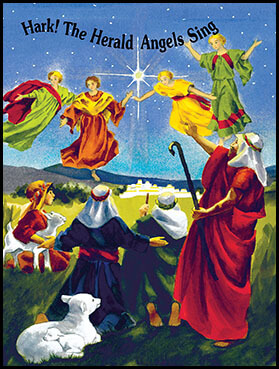 | Hark! The Herald Angels SingFelix Mendelssohn (music), Charles Wesley (words) |
Writer(s): Felix Mendelssohn (music), Charles Wesley (words) (see lyrics here) First Charted: December 14, 1912 (Trinity Choir) Peak (all versions): 4 PM, 14 AC, 41 CW, 1 DF (Click for codes to charts.) Sales (in millions): -- Airplay/Streaming (in millions – all versions): -- radio, 74.7 video, -- streaming |
Awards:Click on award for more details. |
About the Song:Bethel Lutheran College says no other hymn “has won such universal favor…except ‘Rock of Ages.’” BLC ClassicFM.com says the carol is “one of the most recognisable and popular ones…[with] a cracking descant.” CFM “Hark! The Herald Angels Sing” first appeared in the collection Hymns and Sacred Poems in 1739. The English Christmas carol is based on the Biblical passage Luke 2:14 about a chorus of angels singing praises to God. Charles Wesley, who wrote text for more than 6000 hymns, SF wrote the original version as “Hymn for Christmas Day.” WK He was inspired by the sounds of church bells while walking to church on Christmas day. SF It consisted of ten four-lined stanzas and opened with the line “Hark! How all the welkin rings, Glory to the King of kings.” BLC In 1753, George Whitefield published the carol in Collection of Hymns for Social Worship with a change to the opening words. Now it started with the more familiar “Hark! The herald angels sing, Glory to the newborn King.” BLC The first six stanzas would later be combined into three eight-lined stanzas with the first two lines added as a refrain. BLC It would be over a century before “Hark!” was set to music by Felix Mendessohn. In 1840, he composed the cantata Festgesang (Festival Song) to commemorate the 400th anniversary of the invention of movable type by Johannes Gutenberg. In 1855, William Hayman Cummings, an organist at Waltham Abbey Church, adapted “Gott Ist Licht” (God Is Light), the second movement from the piece, to fit with the lyrics of “Hark! The Herald Angels Sing.” SF It was first published in Richard Chope’s Congregational Hymn and Tune Book of 1857. WH The song first charted in 1912 when the Trinity Choir reached #4 on the pop charts. The only other song they charted was a #5 version of “Joy to the World” in 1911. PM The group included Elise Stevenson as a member. She charted nineteen hits from 1907 to 1911, including the #1 songs “Because You’re You,” “Are You Sincere?,” “Good Evening, Caroline,” and “Shine on, Harvest Moon.” PM Resources:
First posted 12/21/2023. |








No comments:
Post a Comment